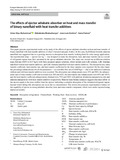JavaScript is disabled for your browser. Some features of this site may not work without it.
| dc.contributor.author | Muhammad, Umar Aliyu | |
| dc.contributor.author | Bhattacharyya, Debabrata | |
| dc.contributor.author | Endrino, José L. | |
| dc.contributor.author | Fereres, Sonia | |
| dc.date.accessioned | 2021-09-01T14:33:08Z | |
| dc.date.available | 2021-09-01T14:33:08Z | |
| dc.date.issued | 2021-08-30 | |
| dc.identifier.citation | Muhammad UA, Bhattacharyya D, Endrino JL, Fereres S. (2021) The effects of ejector adiabatic absorber on heat and mass transfer of binary nanofluid with heat transfer additives. Emergent Materials, Volume 4, Issue 6, December 2021, pp. 1665–1678 | en_UK |
| dc.identifier.issn | 2522-5731 | |
| dc.identifier.uri | https://doi.org/10.1007/s42247-021-00287-2 | |
| dc.identifier.uri | https://dspace.lib.cranfield.ac.uk/handle/1826/17046 | |
| dc.description.abstract | This paper presents experimental results on the study of the effects of ejector adiabatic absorber on heat and mass transfer of binary nanofluid with heat transfer additives (2-ethyl-1-hexanol and gum Arabic). In this case, H2O/lithium bromide-alumina nanofluid was suggested due to a growing interest in absorption heat transfer working fluid for solar energy application. An experimental setup — ejector test rig — was designed to study the absorption, heat, and mass transfer rate as a result of refrigerant vapour mass flow entrained by the ejector adiabatic absorber. The study was carried out at different solution mass flowrate (0.051 to 0.17 kg/s) with three prepared sample solutions, which include pure LiBr solution, LiBr-Alumina nanofluid without heat transfer additives, and LiBr-Alumina nanofluid with heat transfer additives. The absorption rate, mass transfer coefficient, heat transfer rate, and heat transfer coefficient for the three samples were reported. On the other hand, the percentage enhancements for all the parameters — at a suitable flow rate of 0.085 kg/s — due to the addition of alumina without and with heat transfer additives were recorded. The absorption rate enhancements were 25% and 96%, the enhancement rates of mass transfer coefficient recorded were 20% and 82%, the heat transfer rate enhancements were 85% and 183%, and the heat transfer coefficient enhancements obtained were 72% and 156% with addition of alumina nanoparticles only and alumina nanoparticles with heat transfer additives respectively. Material mass balance analysis suggests that mass inflow in the ejector equals to the mass outflow from the ejector, indicating a complete absorption of the entrained refrigerant vapour beyond which falling film absorption can occur due to concentration. This article also presents experimental evidence of the capability of ejector as strong adiabatic absorber, heat, and mass transfer component, which were earlier reported using numerical models | en_UK |
| dc.language.iso | en | en_UK |
| dc.publisher | Springer | en_UK |
| dc.rights | Attribution 4.0 International | * |
| dc.rights.uri | http://creativecommons.org/licenses/by/4.0/ | * |
| dc.subject | H2O/LiBr | en_UK |
| dc.subject | Heat recovery | en_UK |
| dc.subject | Working fuid | en_UK |
| dc.subject | Thermofuids | en_UK |
| dc.subject | Absorption refrigeration | en_UK |
| dc.title | The effects of ejector adiabatic absorber on heat and mass transfer of binary nanofluid with heat transfer additives | en_UK |
| dc.type | Article | en_UK |
Files in this item
The following license files are associated with this item:
This item appears in the following Collection(s)
-
Staff publications (SATM) [4397]

